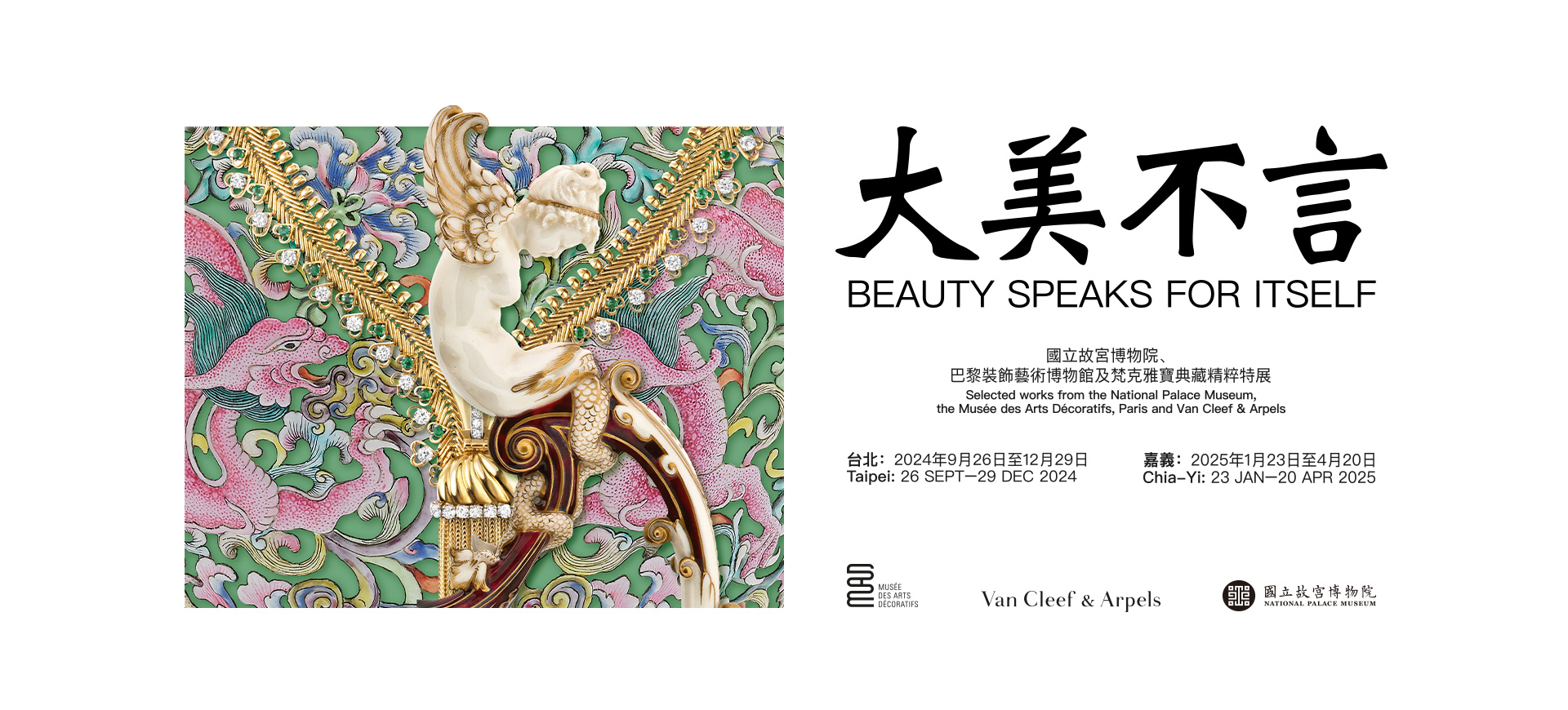Introduction
Beauty Speaks for Itself showcases multiple art forms—the result of a three-way dialogue between the National Palace Museum, the Paris’ Musée des Arts Décoratifs, and High Jewelry Maison Van Cleef & Arpels. Bringing together over 260 associated works in the immersive form of ‘tableaux,’ the exhibition takes place twice, in two different locations: from September 26 to December 29, 2024, in Taipei, then from January 23 to April 20, 2025, in Chiayi.
Beauty Speaks for Itself showcases follows a thematic journey created thanks to the expertise of a team of National Palace Museum Curators as well as Béatrice Quette, Curator of Paris’ Musée des Arts Décoratifs and Head of the Asian and Islamic collections, and Alexandrine Maviel Sonet, Van Cleef & Arpels’Patrimony and Exhibitions Director. The assembled works—96 from the National Palace Museum, 80 from the Musée des Arts Décoratifs, and 85 from Van Cleef & Arpels’ patrimonial Collection—showcase the universal beauty of art. Despite their temporal and geographical disparities, their material, technical, and visual similarities have facilitated their categorization into five sections: nature, movement, fantasy, secrets, and colors.
The first category focuses on nature, showcasing how artists have captured the beauty of the intrisically ephemeral natural world. The second category explores movement, displaying the diverse poses and dynamic qualities of the works through their materials and shapes. The third category, fantasy, unveils the imaginative and supernatural worlds, revealing creatures and enchanting beings that reflect the unique visions of different cultures and eras regarding the universe. The fourth category, secrets, includes exhibits whose functions may not be immediately apparent. They invite visitors to closely examine and uncover their intriguing secrets, which may even include hidden transformative uses or exceptional craftsmanship. Finally, the fifth category, colors, presents a diverse chromatic vocabulary, exploring their meanings and interpretations across different time periods and cultural backgrounds.
Beyond the connections that they forge, the exhibition’s five sections also elicit contemplation and reverie. Each illustrates artistic creativity, testifies to the richness of traditional savoir-faire, and attests to the importance of intercultural exchanges throughout history. Presented in an immersive, colorful, and poetic scenography imagined by Tsuyoshi Tane, ATTA – Atelier Tsuyoshi Tane Architects, this exhibition is an invitation to discover the beauty of exceptional savoir-faire and, more broadly, of art itself.
-
Revolving openwork vase with dragon and lotus decoration in yangcai painted enamels
Qing dynasty, Qianlong reign (1736–1795)
Ceramic
National Palace MuseumThe structure of this Qianlong-period vase is particularly complex, consisting of four interlocking revolving parts. The piece is richly decorated, with clouds in five colors, red bats, traditional ruyi motifs (two rings coiling towards one another, terminating at mirrored points), and lotus and banana leaves. The ornamentation is complemented by delicate openwork forming two pairs of carved double dragons holding lotus flowers and lingzhi mushrooms. The numerous combinations of these different embellishments are further multiplied thanks to the piece’s revolving function. The craftsmanship, mechanisms, and decorations of this work speak to all five sections of the exhibition.
-
Buire de Blois
Manufacture nationale de Sèvres, France, 1883–1884,
Albert-Ernest Carrier-Belleuse (drawing),
Auguste Rodin & Thomas-Jules Roger (sculptors),
Suzanne Estelle-Apoil (painter)
Porcelain, enamel, and gilding
Musée des Arts Décoratifs, deposit of Sèvres – Manufacture et Musée nationauxThis Buire de Blois is a fine example of 19th-century luxury production à la française. At the time, the Manufacture nationale de Sèvres supplied porcelain tableware and other objects all throughout Europe, combining exceptional technical savoir-faire with the talent of renowned artists: sculptor Albert-Ernest Carrier-Belleuse to design objects, decorations, and sculptures, Auguste Rodin and Thomas-Jules Roger to sculpt high reliefs, and Suzanne Estelle-Apoil to paint decorations on the vessels, here inspired by the French Renaissance period. The background colors and pâte-sur-pâte decorations were inspired by Asian ceramics, whose techniques were uncovered by the factory. The aesthetic and technical characteristics of this work embody the themes of each of the exhibition’s five sections.
-
Zip necklace
1952
Convertible into a bracelet
Yellow gold, platinum, emeralds, and diamonds
Van Cleef & Arpels CollectionThe Zip necklace, an avant-garde piece imagined by Van Cleef & Arpels, is remarkable for its ingenuity. Its design was inspired by the zip fastener, first used for aviator jackets and uniforms, and then introduced to the world of couture in the 1930s. Influenced by these fashion circles, the Maison adapted this mechanism into a jewelry creation. Patented in 1938 and produced in 1950, the Zip can be worn in several ways: open, as a necklace, or closed, as a bracelet, thanks to the fringed tassel fastener sliding along its length. This 1952 Zip necklace is lined with heart motifs in rolled gold-filled wire and punctuated with emeralds and diamonds. Evoking a sense of movement and secrecy, this piece demonstrates the Maison’s taste for transformability.


